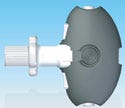The recent Palm Pistol debacle underscores how easy FDA’s systems are to potentially manipulate and abuse.
February 1, 2009
WASHINGTON WRAP-UP
|
Imagine a device so dangerous that it can't even be listed by FDA. Then imagine FDA classifying the device as a Class I medical device exempt from 510(k) premarket notification.
This happened in December, and after a week of media uproar over it, the agency acted with commendable and rare speed by delisting the device and refunding the manufacturer's registration fee.
The device in question was Maplewood, NJ–based Constitution Arms' single-shot 9-mm Palm Pistol. It is listed by FDA as a “daily assist recreational adaptor” under 21 CFR 890.5050—pursuant to the manufacturer's plan to get it recognized as durable medical equipment by CMS. That way, physicians could write prescriptions for it and their patients could receive reimbursement.
Operated by thumb pressure on a button instead of a finger-pull, the barely visible device protrudes less than an inch between the second and third fingers of the holder's fisted hand.
The company's strategy was well thought-out. Its Web site said the pistol was “ideal for seniors, disabled, or others who may have limited strength or manual dexterity.” The site also added that the company planned “a limited initial production run with a projected retail cost of $300. Interested parties may reserve one with a small fully refundable deposit of $25 from your credit card.”
|
|
The Palm Pistol's Web site says the device is “ideal for seniors, disabled, or others who may have limited strength or manual dexterity.” There are no medical claims listed on the site. |
The gun's online specifications document said “its use as a medical device is anticipated.” For designation purposes by CMS, the document said, the gun must meet the federal definition of “equipment that is capable of withstanding repeated use, is primarily used to serve a medical purpose, generally is not useful to an individual in the absence of an illness or injury, and is appropriate for use in the home.” Constitution Arms argued that the pistol meets this definition because it can withstand repeated use, the medical purpose it serves is extending life expectancy, and that all living individuals are subject to the “injury” of shortened life expectancy due to loss of life from criminal assault. Finally, it most assuredly is appropriate for use in the home. The specifications document continued:
An additional function of the device is prevention of sudden-onset death, analogous to the benefits offered by on-body alarm systems, which permit independent unassisted living without the need for certified nursing assistants. If we are successful in obtaining [durable medical equipment] coding, it is possible [that] the medically prescribed purchase of the Palm Pistol will be reimbursable by Medicare or private health insurance companies for qualified insureds.
Medical indications for use include but are not limited to arthritis; peripheral neuropathy caused by chemotherapy, infection, traumatic injury, or diabetes; phalangeal amputations/fusions/fractures; distal muscular dystrophy; multiple sclerosis, carpal tunnel syndrome, Raynaud's syndrome; ganglion cysts; side effects of certain medications; and inclusion body myositis.
In response to my inquiry, Constitution Arms' Matthew Carmel said FDA had “instructed us to list (not approve) the Palm Pistol as a Class I medical device exempt from 510(k) premarket notification.” He said this came from consumer safety officer Geoffrey Clark.
Of course the media had a field day with all of this, deluging FDA's press office with inquiries. Officials scrambled before an onslaught of sarcastic articles. Nothing lights a hotter fire under a bureaucrat than ridicule from which there is no escape.
Eight days after the registration, a deadpan FDA press office spokeswoman began contacting interested reporters to declare that “because FDA has determined the product is not a medical device under Section 201(h) of the [Federal Food, Drug, and Cosmetic]Act, FDA is canceling the registration and will return its registration fee. It appears,” she continued, “that Constitution Arms registered the company and listed the Palm Pistol as a ‘recreational adaptor,' which may be a daily assist device under 21 CFR 890.5050. However, registration and listing does not constitute an admission, agreement, or determination that a product is a device within the meaning of Section 201(h) of the Act. FDA has determined that the company's listing was in error.”
No official press release was issued, which limits FDA's embarrassment by not alerting those who had not already covered the debacle.
Lessons to be learned from this bizarre episode are that first, FDA's online device listing and registration process is too easy and open to manipulation and abuse. Also, public transparency and external attention are important to the agency's proper functioning.
Grassley Delves into Heart Valve Repair
|
Senator Grassley is investigating whether the Myxo ring was cleared or approved for use in clinical research. |
Senate Finance Committee minority member and self-appointed FDA overseer Charles Grassley (R–IA) has asked the agency whether it has cleared or approved for use in clinical research an Edwards Lifesciences device used in heart valve repair. The device was implanted in some patients at Northwestern Memorial Hospital in Chicago. Grassley said he has received allegations that FDA never approved use of the Myxo ETlogix 5100 Ring (Myxo ring).
In a December 3 letter to now-former FDA commissioner Andrew von Eschenbach, Grassley says it appears that the device has been implanted in patients by cardiothoracic surgeon Patrick McCarthy despite lack of a 510(k) clearance or an investigational device exemption (IDE). He said allegations were raised to the committee by a professor at the Northwestern University School of Medicine and a patient who reportedly was implanted with the ring without informed consent.
|
Grassley said the two whistle-blowers raised their concerns with the university and were informed that a Northwestern Office for Research Integrity investigation had found that implantation of the ring was “not research and did not require [institutional review board] approval.” The investigation also cited a letter from Edwards Lifesciences stating that the product was commercially available and has been marketed since March 2006 pursuant to FDA's 510(k) process.
Committee staff searched the FDA Web site and could find no information on approval for the Myxo ring, Grassley said. Rather, he said, all that was found were eight adverse-event reports submitted to FDA's Manufacturer and User Device Experience database. He asked von Eschenbach for answers to the following questions:
Has FDA received any information and/or a 510(k) application from Edwards for the Myxo ring? Has FDA ever reviewed the device for marketing and, if so, what was the decision?
Did Edwards report to FDA that its Myxo ring is a minor modification of its Model 4200 GeoForm annuloplasty ring and, if so, when, to whom, and how was that information communicated to FDA?
If the Myxo ring has not been cleared for commercial use, should implantation be conducted under an IDE?
What type of reporting is required of 510(k) holders when they modify their devices, and how does FDA ensure that a 510(k) holder has made the appropriate decision on whether to submit a 510(k) when modifications are made to a legally marketed device?
The patient who raised allegations about implantation of the device said she sent a report to FDA and that the agency acknowledged it had never approved the device and was investigating. Grassley asked for a committee staff briefing as soon as the investigation is complete.
Grassley also wrote to the manufacturer and to the hospital requesting information on the device and its use. Edwards has since released a statement saying that it will fully cooperate with the senator's inquiry.
Unnamed OEM's Manager Guilty of Illegal Sales
Potential Penalties by the Numbers 8 |
A former manager for an unnamed Hopkinton, MA, medical device manufacturer has pleaded guilty in Massachusetts federal court to one count of making a false statement and one count of felony misbranding.
Darnell Martin, 35, of Chicago, faces up to five years in prison, followed by three years of supervised release and a $250,000 fine on the false statement charge. He faces up to three years in prison, one year of supervised release, and a $10,000 fine on the misbranding charge.
Prosecutors said Martin worked for a company that manufactured and sold medical devices designed to promote bone growth. The devices were approved by FDA under a humanitarian device exemption. Martin reportedly falsified an institutional review board approval in May 2007, which led to a number of the devices being shipped, billed, and used by a medical facility in Wisconsin. He also reportedly promoted use of the devices in a manner that differed from their approved use; prosecutors said he promoted a combination of the devices with a bone void filler and provided written mixing instructions to surgeons, medical technicians, and others.
Government officials said the case was investigated by FDA's Office of Criminal Investigations and the HHS inspector general. It was prosecuted by the U.S. attorney's healthcare fraud unit in Boston.
FDA Mulls Clinical Trials for Cardio Leads
Hauser's Big Four Cardiologist Robert Hauser challenged FDA's approach as not being in the best interest of patients for the following four reasons:
|
FDA has not yet decided whether to require premarket clinical trials for new implantable cardioverter-defibrillator (ICD) four-pole connector leads, according to CDRH director Daniel Schultz. His comments were in a written response to a New England Journal of Medicine column that called for such trials.
Minneapolis Heart Institute cardiologist Robert Hauser wrote that at a Heart Rhythm Society meeting in May, an FDA official said the agency would not require and companies would not conduct premarket clinical testing of the new lead before it is approved for routine implantation. Rather, he said, FDA and industry plan to conduct postmarketing surveillance studies to detect problems with the four-pole connector and provide sufficient data to guide patient care.
Hauser quoted the unnamed FDA official as saying that the new technology should be approvable based on engineering and animal tests. And he said that FDA indicated a desire not to suppress innovation for the sake of a clinical trial that may be difficult to conduct. Industry executives, according to Hauser, are concerned about the costs of a trial and want to introduce the new technology as quickly as possible.
Hauser challenged that approach as not being in the best interest of patients (see the story, “Hauser's Big Four,” below).
But Schultz responded that the decision on clinical tests is still being considered. “When we are evaluating an application for a modification of a device, our questions are sometimes best answered by appropriate engineering analyses and often through the use of clinical data,” he wrote.
“Clinical experience with similar models of the device can provide insight into a new device's expected clinical performance. Sometimes, nonclinical studies can be more informative than clinical evaluation with regard to device safety and effectiveness.” Schultz also said that when preclinical studies and existing clinical data support approval—and expected long-term failure rates are low—postapproval studies may offer a clear picture of long-term device performance.
Senator Seeks Action on Tainted Dental Implants
Senator Sherrod Brown (D–OH) has urged FDA to take tougher action against lead-contaminated dental implants imported into the United States, saying that they have harmed Americans.
“As reports of tainted implants increase, it is essential that FDA take action to ensure the safety of these dental products,” Brown said in news release issued by his office. “CDC determined that lead levels under 200 parts per million are safe. However, some of the dental implants tested by Ohio labs indicate higher levels of lead than that ceiling.”
In a letter to outgoing FDA commissioner Andrew von Eschenbach, Brown asked von Eschenbach for answers to the following questions:
What standards exist for domestic and international dental products and the dental labs that produce them?
What is the estimated volume of China-produced dental implants in the United States, and what is the annual volume of such products?
What tracking mechanisms are in place to prepare for potential contamination by tainted dental implants?
What inspection mechanisms are in place to ensure the safety of dental implants?
What are the risks posed by dental implants with lead levels above those that the CDC has determined are safe?
He asked for the questions to be answered as quickly as possible due to “the seriousness of the matter.”
FDA Issues 510(k) Sterility Draft Guidance
FDA has issued a draft guidance for industry and agency staff, Submission and Review of Sterility Information in Premarket Notification (510(k)) Submissions for Devices Labeled as Sterile, to update and clarify procedures for reviewing 510(k) submissions for devices labeled as sterile, particularly procedures involving novel sterilization techniques.
The guidance also gives details on pyrogenicity information recommended to be included in a 510(k) submission and addresses information on sterilization processes that should be included in 510(k)s for devices labeled as sterile. When finalized, the guidance will supersede the August 30, 2002, guidance Updated 510(k) Sterility Review Guidance K90-1.
The guidance may be accessed at www.fda.gov/cdrh/ode/guidance/1615.html.
FDA Clarifies Requirements for PMA Modifications
CDRH has issued a guidance for industry and FDA staff to provide underlying principles and examples to determine the type of regulatory submission that may be required to modify a lawfully marketed premarket approval device. The guidance, titled Modifications to Devices Subject to Premarket Approval (PMA)—The PMA Supplement Decision-Making Process, applies to Class III devices that are subject to PMA requirements. It applies to PMAs reviewed by CDRH and CBER and also applies if a sponsor modifies a PMA device in response to a recall or field corrective action to ensure the device's continued safety and effectiveness.
The guidance covers background information, general requirements for when a PMA supplement is needed, determining the type of PMA submission, and periodic reports.
Access the guidance at www.fda.gov/cdrh/ode/guidance/1584.pdf.
Contract Medical Cited for Quality System Violations
A recent FDA inspection of Contract Medical Manufacturing's Oxford, CT, facility, which produces sterile custom cranial implants, found quality system violations. A November 20 warning letter from FDA's New England district office included the following violations:
Failure to ensure that when the results of a process cannot be fully verified by subsequent inspection and test, that the process is with a high degree of assurance and approved according to established procedures.
Failure to establish and maintain procedures for monitoring and control of process parameters for standard processes to ensure that the specified requirements continue to be met.
Failure to maintain quality system records that include or refer to the location of procedures and activities documentation.
Failure to establish and maintain adequate procedures for finished device acceptance to ensure that each production run, lot, or batch of finished devices meets acceptance criteria and that finished devices are not released for distribution until four criteria are met.
Failure to establish and maintain procedures to ensure that device history records for each batch, lot, or unit are maintained to demonstrate that the device is manufactured in accordance with the device history record.
Failure to review, evaluate, and investigate any complaint involving possible failure of a device, labeling, or packaging to meet specifications.
Failure to promptly review, evaluate, and investigate any complaint that represents an event that must be reported to FDA.
Failure to control labeling operations to prevent labeling mix-ups and to document labeling used in the device history record.
Failure to establish procedures for identifying training needs and ensure that all personnel are trained to adequately perform their assigned responsibilities, and to document such training.
The letter acknowledged receipt of the company's response and said some provisions appeared to be adequate, while others were inadequate. FDA also acknowledged that the company placed a shipping hold on all custom cranial implants until further notice and that the company intended to recall all of its units.
Contract Medical was told to take prompt action to correct the violations and to respond with a list of steps taken or planned to correct the violations and prevent their recurrence, including documentation of all corrective actions taken and a timetable for completion.
FDA Accuses Neuro of Rogue Marketing
Pittsburgh's Neuro Kinetics Inc. is marketing its Neuro-Otological Test Center products without FDA marketing clearance or approval, according to a recent warning letter from FDA's Philadelphia district office. The products are intended for use in vestibular analysis such as the Rotary/Barany Chair Assembly, I-Portal Video Nystagmograph, Opto-Kinetic Projection System, Pursuit Tracker Laser Diode Stimulus; and VEST operating software.
The letter says that FDA's Office of Device Evaluation reviewed the company's marketing brochure and determined that a significant change was made to the Rotary/Barany Chair Assembly, which had previously been cleared. The change requires submission of a new 510(k).
In addition to not obtaining clearance or approval for its products, the company also failed to notify FDA of its intent to introduce them into commercial distribution, the letter says.
Neuro Kinetics was told to take prompt action to correct the violations, to advise the district office of steps it has taken, and to explain how the company will prevent such violations from happening again.
Copyright ©2009 Medical Device & Diagnostic Industry
About the Author(s)
You May Also Like






